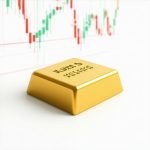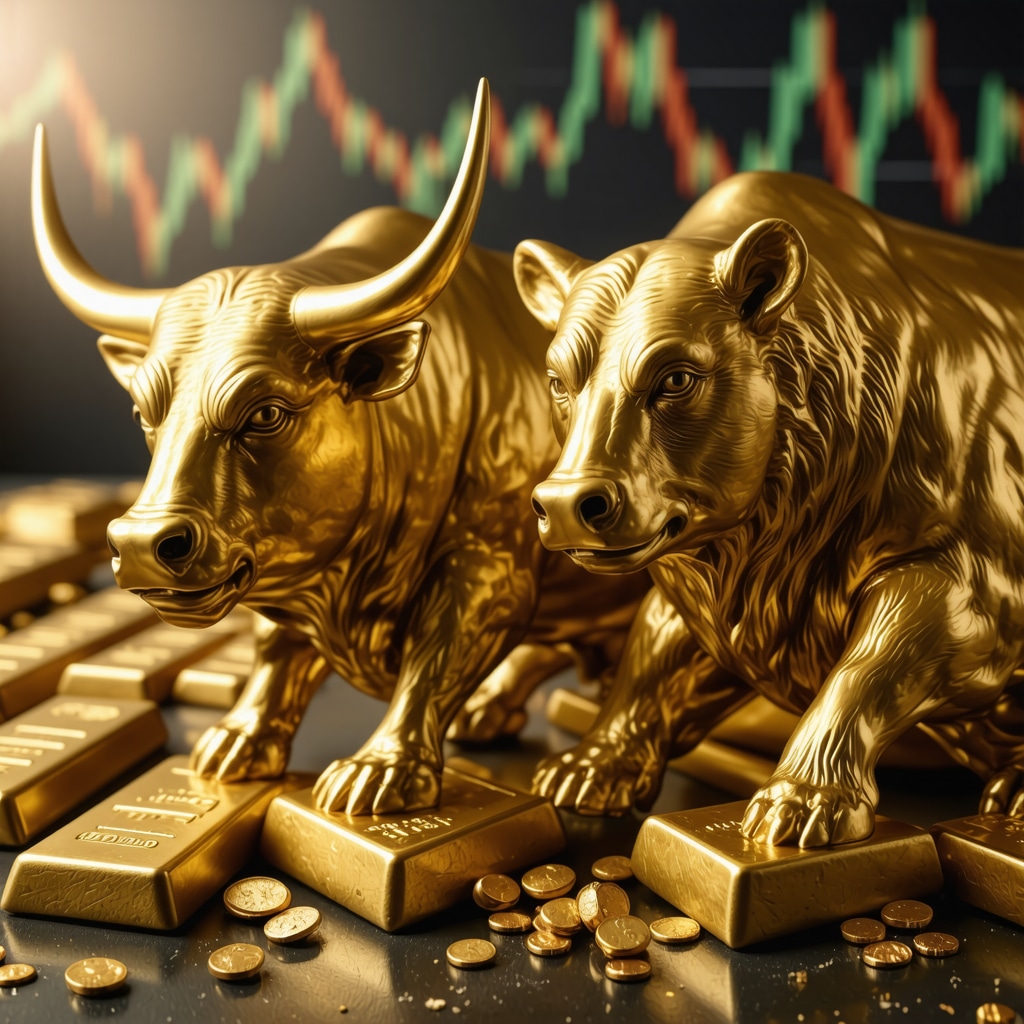Unlocking the Future: Why Gold Price Trends Matter More Than Ever in 2025
As investors navigate the shifting sands of global economies, understanding gold price trends in 2025 becomes crucial for timing purchases and maximizing returns. Gold, long revered as a safe haven, now faces a complex interplay of geopolitical tensions, inflationary pressures, and evolving supply-demand dynamics. This article delves deep into expert forecasts and market signals that illuminate when and why buying gold this year could be a game-changer for your portfolio.
Decoding Economic Drivers Behind 2025’s Gold Price Movements
The trajectory of gold prices in 2025 is shaped significantly by macroeconomic indicators. Central bank policies, especially interest rate adjustments by the Federal Reserve and other leading institutions, play a critical role. Lower real interest rates often boost gold’s appeal as an inflation hedge. Additionally, persistent inflation concerns amid supply chain realignments and energy price volatility underscore gold’s status as a refuge.
Moreover, the ongoing geopolitical uncertainties—from trade negotiations to regional conflicts—can ignite sudden surges in gold demand. These factors combine to create a price environment marked by both opportunity and risk, warranting a nuanced investment approach.
How Does Global Gold Supply and Demand Influence 2025 Price Forecasts?
Understanding the supply and demand dynamics is indispensable for forecasting gold prices. Mining output is expected to remain relatively stable with modest growth, but demand from emerging markets, particularly India and China, continues to rise due to cultural affinity and wealth expansion. Central banks have also been net buyers, adding to upward pressure on prices.
Innovations in gold recycling and ETFs have introduced new liquidity layers, subtly influencing market behavior. Investors should watch these demand channels closely to anticipate price swings.
Strategic Buying Windows: Insights from Market Patterns and Expert Analysis
Historical data combined with contemporary forecast models highlight specific windows in 2025 where purchasing gold might be optimal. For instance, periods following major economic data releases or central bank announcements often exhibit price corrections or volatility spikes. Seasonality also plays a role; traditionally, the second quarter sees increased buying ahead of festivals and wedding seasons in key Asian markets.
Active investors might consider leveraging gold price forecasts and technical indicators to time entries, while long-term holders should balance between physical gold and diversified instruments like gold mutual funds or ETFs to mitigate risks.
Gold Investment Vehicles: Aligning Your Strategy with Market Realities
Choosing the right gold investment vehicle is as critical as timing. Physical gold offers tangible security but requires safe storage solutions. Alternatively, gold ETFs and mutual funds provide liquidity and diversification but are subject to market fluctuations.
Exploring various investment options can help tailor a strategy that matches your risk tolerance and financial goals. Balancing these options is essential for capitalizing on the anticipated gold price trends in 2025.
What Should Investors Consider Before Deciding When to Buy Gold in 2025?
Investors must evaluate macroeconomic forecasts, personal investment timelines, and risk appetites. Given the potential for volatility, a staggered purchase approach may reduce exposure to sudden price swings. Staying informed through reputable sources and expert analyses enhances decision-making precision.
For an in-depth understanding of how gold acts as a hedge against economic uncertainty, consider this insightful resource: How Gold Acts as a Hedge Against Market Uncertainty in 2025.
Curious about optimizing your gold investment strategy? Share your thoughts or questions below and join the conversation to stay ahead in the dynamic gold market.
For further authoritative insights, the World Gold Council offers comprehensive research and up-to-date market analysis that investors find invaluable: World Gold Council Research Hub.
Reflecting on the Emotional Side of Gold Investing in 2025
When I first dipped my toes into gold investment, I was struck not only by the numbers but by the emotional roller coaster that came with watching the gold price trends unfold. The uncertainty around inflation, geopolitical risks, and macroeconomic shifts can make the market feel like a high-stakes poker game. What helped me stay grounded was reminding myself that gold’s historical resilience offers a kind of financial sanctuary – a lesson echoed by the World Gold Council in their ongoing research.
For instance, during periods of geopolitical tension, such as trade disputes or regional conflicts, I noticed how gold prices often surged unexpectedly. This pattern isn’t just anecdotal; it’s a reflection of gold’s role as a safe-haven asset. Recognizing these emotional and psychological drivers behind market movements helped me develop a more patient and strategic approach.
Balancing Physical Gold and Digital Options: What Works Best for You?
One of the dilemmas I faced was choosing between physical gold and its digital counterparts like ETFs and mutual funds. Each has its own charm and challenges. Physical gold offers tangible security but requires careful storage and insurance, which can be a hassle. On the other hand, gold ETFs and mutual funds provide liquidity and diversification but expose you to market volatility.
Over time, I found that a hybrid approach suited me best. Holding physical gold as a core asset for long-term security, complemented by selective investments in gold mutual funds, allowed me to capture growth opportunities while managing risk. For those new to gold investing, exploring top gold mutual funds for safe long-term growth is a great way to start.
How Do You Decide When to Buy Gold Amidst So Much Market Noise?
This is a question I often get asked, and it’s one I wrestled with myself. The truth is, timing the market perfectly is nearly impossible. What has worked for me is focusing on broader economic signals and personal financial goals rather than daily price fluctuations. For example, watching for central bank announcements or seasonal demand spikes, especially in the second quarter, helped me identify strategic buying windows.
Moreover, adopting a dollar-cost averaging strategy, purchasing gold incrementally over time, smoothed out the impact of market volatility. This approach aligns well with insights shared in gold price forecast analyses, which emphasize patience and diversification to mitigate risk.
Practical Tips from Experience: Avoiding Common Pitfalls
One crucial lesson I learned early on is the importance of verifying dealers and understanding product authenticity. The gold market, while lucrative, has its share of pitfalls. Always buy from reputable sources and seek certifications especially when purchasing physical gold. I recommend checking out guides like safe gold investment tips for new buyers to stay informed.
Additionally, storage solutions shouldn’t be an afterthought. Whether you opt for a home safe, bank deposit box, or professional vault services, secure storage preserves your investment’s value and your peace of mind. This practical aspect of gold investing is often overlooked but makes all the difference.
What has been your experience with gold investment strategies in 2025? Have you found a preferred balance between physical and digital gold? Feel free to share your thoughts, questions, or stories below – your insights might just help someone else navigate this fascinating market!
Harnessing Quantitative Models: The Cutting-Edge Approach to Predicting Gold Price Fluctuations
In 2025, the gold market complexity demands more than traditional analysis; it requires leveraging sophisticated quantitative models that integrate multifactor economic variables, sentiment indices, and machine learning algorithms. These models excel at capturing nonlinear relationships between gold prices and macroeconomic drivers such as interest rates, currency fluctuations, and geopolitical risk metrics.
For example, recent advances in predictive analytics utilize ensemble learning methods to blend historical price data with real-time news sentiment, thereby enhancing the accuracy of short- to medium-term forecasts. Such approaches allow investors to anticipate volatility spikes triggered by unexpected geopolitical events or shifts in monetary policy. This paradigm shift from purely fundamental or technical analysis to hybrid modeling represents the frontier of expert gold price forecasting.
How Can Investors Integrate Machine Learning Insights with Traditional Gold Price Analysis for Better Outcomes?
Integrating machine learning insights requires a comprehensive understanding of both data-driven predictions and classic market signals. Investors should use algorithmic forecasts as a complementary tool rather than a standalone solution. For instance, coupling model outputs with fundamental analysis—such as central bank announcements and gold supply-demand shifts—enables more nuanced decision-making.
Furthermore, by continuously validating model performance against emerging market data, investors can recalibrate strategies in near real-time, optimizing buy/sell timing. This iterative process demands technical literacy and access to high-quality datasets but rewards with an adaptive investment edge.
For those keen on exploring this advanced technique, the CFA Institute’s comprehensive review on quantitative commodity pricing offers an authoritative deep dive into applying these methods specifically to precious metals like gold.
Psychological Finance: Decoding Investor Behavior and Its Impact on 2025 Gold Market Dynamics
While models and fundamentals are vital, understanding the behavioral finance aspects behind gold investing can reveal hidden market forces. Investor sentiment often drives short-term gold price anomalies, especially during periods of high uncertainty or fear. Cognitive biases such as herd behavior, loss aversion, and overconfidence can amplify price swings beyond what fundamentals justify.
Expert investors track sentiment indicators—like the Commitment of Traders (COT) reports and volatility indices—to gauge prevailing market moods. These insights help anticipate contrarian opportunities where gold prices may temporarily overshoot or undershoot intrinsic values.
What Role Does Behavioral Economics Play in Refining Gold Investment Timing Strategies?
Behavioral economics provides a crucial lens to interpret market overreactions and underreactions. By recognizing patterns tied to psychological biases, investors can strategically position themselves ahead of crowd-driven price movements. For example, during geopolitical crises, an initial panic-driven surge in gold prices may be followed by a correction as rational assessments prevail.
Incorporating behavioral signals alongside economic and technical data fosters a holistic investment framework. This multidimensional approach helps mitigate emotional decision-making and enhances timing precision in a notoriously volatile arena.
Exploring Alternative Gold Investment Instruments: Beyond Physical and ETFs
For seasoned investors seeking diversification beyond traditional physical gold and ETFs, alternative instruments like gold futures, options, and structured products offer sophisticated risk management and leverage opportunities. However, these tools require advanced understanding of derivatives pricing, margin requirements, and market liquidity.
Gold futures contracts allow for speculative positioning or hedging against price fluctuations but expose investors to potential margin calls during adverse moves. Options provide asymmetric risk profiles, enabling limited downside with uncapped upside potential. Structured products, combining gold exposure with fixed income or equity components, tailor risk-return characteristics to specific investor goals.
Accessing these instruments typically necessitates brokerage accounts with derivative trading capabilities and a solid grasp of financial engineering concepts.
Ready to elevate your gold investment strategy with advanced analytical tools and diversified instruments? Join our exclusive webinar series where industry experts dissect market trends, quantitative models, and behavioral insights shaping gold prices in 2025.
Leveraging Sentiment Analytics: The New Frontier in Gold Market Forecasting
Beyond the quantitative models and macroeconomic fundamentals, the integration of sentiment analytics into gold price forecasting represents a cutting-edge evolution in investment strategy. By harnessing natural language processing (NLP) tools to analyze news flows, social media trends, and expert commentary, investors gain real-time gauges of market psychology that complement traditional data streams.
This approach enables the anticipation of market inflection points triggered by shifts in investor mood or geopolitical developments, often before such signals manifest in price charts. Combining sentiment analytics with existing models enhances predictive accuracy and provides a tactical advantage in navigating the nuanced gold landscape of 2025.
How Can Advanced Sentiment Analysis Improve Timing Decisions in Volatile Gold Markets?
Advanced sentiment analysis deciphers the subtle nuances of market narratives, quantifying fear, optimism, or uncertainty with unprecedented granularity. For example, during periods of escalating geopolitical tension, sentiment indexes may spike, signaling a probable surge in safe-haven demand ahead of actual price movements.
Investors employing these insights can adjust entry and exit points proactively, mitigating downside risk while positioning for upside potential. Integrating sentiment data with technical indicators and macroeconomic signals creates a multidimensional decision-making framework that outperforms conventional timing strategies.
For a comprehensive exploration of sentiment-driven investment strategies, the CFA Institute’s research on sentiment analysis in finance offers authoritative guidance and case studies highlighting its application in precious metals markets.
Risk Mitigation Through Dynamic Portfolio Rebalancing in Gold Investments
In 2025’s fluctuating environment, static gold allocations can expose portfolios to undue risk or opportunity costs. Dynamic rebalancing strategies, powered by algorithmic triggers and real-time market monitoring, allow investors to adjust gold holdings in response to evolving economic indicators and price action.
This proactive management helps capture gains during bullish phases while reducing exposure during corrections or liquidity crunches. Incorporating stop-loss mechanisms and periodic stress testing within your gold portfolio safeguards capital and aligns exposures with shifting risk appetites.
Exploring Geo-Economic Scenarios: How Global Power Shifts Shape Gold Valuations
The interplay of emerging economic powers and shifting alliances profoundly influences gold’s investment narrative. For instance, the increasing gold reserves accumulation by Asian central banks contrasts with Western monetary policy tightening, creating divergent forces that drive price complexity.
Investors attuned to these geo-economic scenarios can anticipate structural shifts in demand and supply balances, enabling more informed strategic positioning. Scenario analysis tools that model outcomes from trade wars, currency realignments, or resource nationalism sharpen forecasting precision in this multifaceted context.
Engage with Cutting-Edge Gold Market Intelligence
Elevate your investment acumen by embracing these advanced methodologies and insights. Stay connected with industry thought leaders, participate in specialized forums, and leverage proprietary analytics to maintain a competitive edge. Ready to transform your gold investment approach with these expert strategies? Dive deeper, ask questions, and share your experiences to enrich your understanding and that of the community.
Frequently Asked Questions (FAQ)
What factors primarily influence gold price trends in 2025?
Gold prices in 2025 are chiefly driven by macroeconomic indicators including central bank monetary policies, inflation rates, geopolitical tensions, and shifts in global supply and demand. Interest rate changes, especially real rates, significantly affect gold’s appeal as an inflation hedge, while geopolitical uncertainties amplify safe-haven demand.
How do geopolitical events impact gold prices during volatile periods?
Geopolitical crises such as trade disputes, regional conflicts, or international sanctions typically trigger sudden spikes in gold prices due to increased investor risk aversion. Gold’s role as a safe-haven asset means that during heightened uncertainty, demand surges, often preceding price movements captured by sentiment analytics.
What investment vehicles are best suited for different investor profiles in 2025?
Physical gold suits investors seeking tangible security and long-term preservation. For those prioritizing liquidity and diversification, ETFs and mutual funds offer accessible exposure. Advanced investors might consider futures, options, or structured products for leveraging and hedging, though these require sophisticated understanding and tolerance for risk.
How can machine learning and quantitative models improve gold price forecasts?
Machine learning integrates multifactor economic data and sentiment indicators to capture complex, nonlinear relationships affecting gold prices. These models enhance forecast accuracy by combining historical trends with real-time information, enabling adaptive strategies and better timing of buy/sell decisions when used alongside traditional analysis.
Why is understanding investor psychology important in gold market timing?
Behavioral finance reveals how cognitive biases like herd behavior and loss aversion influence market dynamics, often causing price volatility beyond fundamental values. Recognizing these patterns allows investors to anticipate overreactions or corrections, refining timing strategies and mitigating emotional decision-making.
What are the risks associated with alternative gold instruments like futures and options?
While offering leverage and tailored risk profiles, futures and options expose investors to margin calls, rapid price swings, and liquidity constraints. These instruments demand advanced knowledge of derivatives and risk management, making them suitable primarily for experienced investors comfortable with higher complexity and volatility.
How does sentiment analytics provide an edge in volatile gold markets?
Sentiment analytics use natural language processing to quantify market mood from news, social media, and expert commentary. This real-time insight often detects shifts in investor psychology ahead of price changes, allowing proactive adjustment of positions and improved timing beyond conventional technical or fundamental indicators.
What strategies help mitigate risk in gold investment portfolios in 2025?
Dynamic portfolio rebalancing employing algorithmic triggers and stress testing helps align gold allocations with evolving market conditions and risk tolerance. Incorporating stop-loss mechanisms and diversifying across physical and digital assets reduces exposure during downturns while capturing upside during bullish phases.
How do global power shifts influence gold valuations?
Emerging economic powers accumulating gold reserves and contrasting monetary policies create complex demand-supply dynamics. Geopolitical realignments, trade wars, and currency fluctuations shape structural trends in gold valuation, making scenario analysis critical for anticipating long-term price movements.
What practical tips should new gold investors follow to avoid common pitfalls?
New investors should always verify dealer reputations, seek certified products, and prioritize secure storage solutions. Diversifying investment vehicles and adopting a staggered buying approach reduce risks from market volatility. Staying informed through reputable sources enhances decision-making and safeguards capital.
Trusted External Sources
- World Gold Council (WGC): The premier authority offering comprehensive research on gold supply-demand dynamics, market trends, and investment strategies, essential for understanding gold price movements and safe-haven behavior.
- CFA Institute Research: Provides in-depth analyses on quantitative commodity pricing, sentiment analysis in finance, and behavioral economics, offering advanced insights into modeling gold price fluctuations and investor psychology.
- International Monetary Fund (IMF): Supplies critical macroeconomic data and reports on global economic outlooks, central bank policies, and geopolitical developments influencing gold markets.
- Bloomberg Terminal: A leading source of real-time financial data, news, and sentiment indicators, invaluable for tracking market sentiment and making timely gold investment decisions.
- Metals Focus: Specialist precious metals research firm delivering detailed forecasts on mining output, recycling, and demand from emerging markets, informing supply-side considerations in gold pricing.
Conclusion
Understanding gold price trends in 2025 demands a multifaceted approach that combines fundamental economic analysis, advanced quantitative modeling, behavioral finance, and sentiment analytics. As geopolitical tensions and inflation concerns persist, gold remains a pivotal asset for diversification and risk mitigation. Selecting appropriate investment vehicles aligned with individual goals and employing dynamic portfolio management enhances resilience in a volatile market.
By integrating cutting-edge technologies and psychological insights, investors can navigate complexities with greater precision, capitalizing on strategic buying windows while safeguarding capital. Gold’s enduring role as a financial sanctuary is reaffirmed in 2025, but success hinges on informed, adaptive strategies.
Engage with this knowledge—share your experiences, explore expert analyses, and apply these insights to elevate your gold investment approach in 2025 and beyond.










